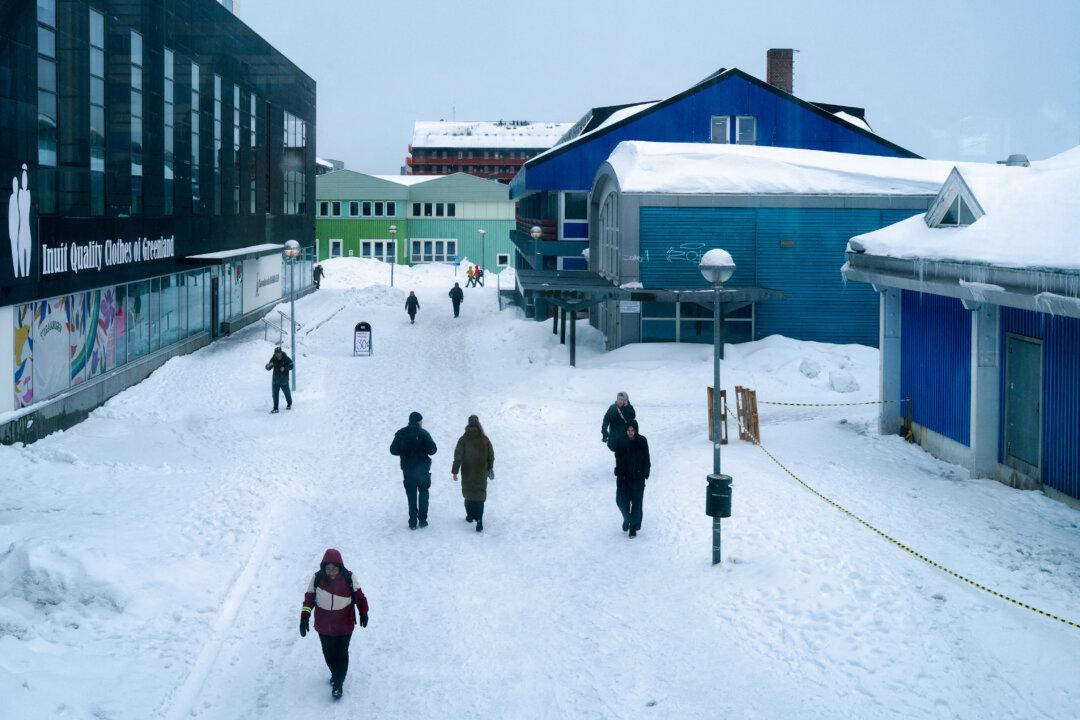WASHINGTON—In a matter of days, the latest Greenland itinerary for a March 28 visit by high-profile Americans was made public, then revised to a destination highlighting U.S. security ties to Greenland—as well as the backlash generated by the initial plan.
On March 23, less than two weeks after the Danish territory’s elections, the White House announced that Second Lady Usha Vance and a U.S. delegation would travel to Greenland to tour cultural sites and watch its national dogsled race, the Avannaata Qimussersu.
“Ms. Vance and the delegation are excited to witness this monumental race and celebrate Greenlandic culture and unity,” the White House wrote.
News of Vance’s trip met with anger from some Greenlandic politicians, who are still in the process of forming a parliament. The March 11 elections saw a center- to center-right party that favors gradual independence, Demokraatit, come in first with about 30 percent of the vote. Naleraq, the party whose leader advocates rapid independence and has broached the idea of U.S. territorial status, finished in second with just below 25 percent of the vote. Other parties favoring independence, often along more gradual timelines, claimed most of the remainder.
The caretaker prime minister, Mute Egede, spoke on Facebook of “American aggression,” calling the scheduled visit “a demonstration of power to us.”
Demokraatit’s leader and the prospective future prime minister, Jens-Frederik Nielsen, wrote on Facebook, “When foreign dignitaries travel to our country on what are called private visits, it rightly causes concern.”
He also said that people should not panic.
“We are in the middle of negotiations for a new coalition,” he wrote. “We must not be pressured.”
Ulrik Pram Gad, a global security researcher specializing in Greenlandic–Danish relations, told The Epoch Times in a March 24 email that the announcement is “yet another instance of the Trump administration not caring about the rule of the game in traditional diplomacy,” saying it amounted to a “pressure campaign on the incoming government.”
James Robbins, dean of academics with the Institute of World Politics and a national security strategist, saw the reaction differently.
“It’s interesting to me that they’re pushing back hard against proposals that really aren’t on the table,” he told The Epoch Times on March 24, saying the Trump administration has not laid out a formal proposal. “We have this big new idea coming out of them, and it’s going to take some time to talk about and to think about.”
Soon after it was announced, the trip’s itinerary and participants changed.
On March 25, the White House announced that the second lady would be joined by her husband, Vice President JD Vance. Instead of watching the dogsled race, they would visit the Pituffik Space Base in Greenland, the central node of a U.S. military presence in Greenland that dates to World War II.
“Neglect and inaction from Danish leaders and past U.S. administrations have presented our adversaries with the opportunity to advance their own priorities in Greenland and the Arctic. President Trump is rightly changing course,” the White House wrote.
There are indications of growing Russian and Chinese attention to the Arctic.
In a March 26 email to The Epoch Times, Gad linked the new plan to planned protests at the dogsled race. Demonstrators were expected to turn their backs on the second lady.
“Passive resistance won the standoff,” he wrote. “They took the safe version of visiting the base where no demonstrations can be expected—but also no images can be produced legitimizing the false narrative that Greenlanders want to be Americans.”
Drew Horn, CEO of the critical minerals firm GreenMet and a past visitor to Greenland, told The Epoch Times in a March 26 emailed statement: “The delegation is giving them the appropriate time and space to form their new government as desired, intent to support Greenland as they wish and not interfering as we see Danish interests and proxies currently doing.
Arctic Security in Focus
Robbins elaborated on those security interests, and what they might look like in the future, in his interview with The Epoch Times.He said melting sea ice in the Arctic could open shipping lanes in the region, making the region more accessible to Russia—at that latitude, closer to Greenland than it may appear.
“If Greenland became an independent country, then they would absolutely have to have some kind of security relationship with somebody, because they wouldn’t be able to defend their country,” Robbins said while also questioning Denmark’s ability to provide that kind of Arctic security.
In February, Denmark announced plans to boost defense spending above 3 percent of gross domestic product.
An independent Greenland “would be able to forge relationships with any other country,” including Russia and China, according to Robbins.
“It would be a threat to us, security-wise, and a threat to the West,” he said.
He anticipates Greenland’s location close to Russia could make it more pivotal to missile defense and early warning systems. For similar reasons, Canada and the United States cooperate on the North Warning System, a network of surveillance radars across Alaska and northern Canada.
Offensive weapons like intercontinental ballistic missiles are a different story. Those land-based strategic nuclear systems “have always been kept in the United States,” he said.
Gad wrote that Danish security experts have likened Trump’s talk regarding Greenland to how Russian leader Vladimir Putin spoke of Crimea prior to annexing it in 2014.
“The recent reactions of the outgoing and incoming prime ministers highlight that by now, most Greenlanders mainly see the U.S. invitations as a threat,” Gad said.
Robbins rejected that analogy, saying that Russia launched an armed invasion after extensive political warfare and subversion. A better comparison, he said, would be the U.S. purchase of the Danish West Indies, which took place in 1916.
Robbins also thinks that perceptions could change, particularly if the terms of any U.S. proposal appeal to the Greenlandic people. As a possible point of comparison, he noted the Alaska General Fund, which distributes oil and gas revenues to state residents. Greenland’s natural resources could enable a similar arrangement.
Robbins also thinks that perceptions could change, particularly if the terms of any U.S. proposal appeal to the Greenlandic people. As a possible point of comparison, he noted the Alaska Permanent Fund, which distributes state minerals revenue to Alaska residents. Greenland’s natural resources could enable a similar arrangement.
“They had this election which put in place a government that’s opposed to the idea. Well, that’s fair enough. That’s up to them. It doesn’t mean you can’t keep discussing it. Maybe they want to hear the offer, because the offer isn’t even on the table yet,” Robbins said.







